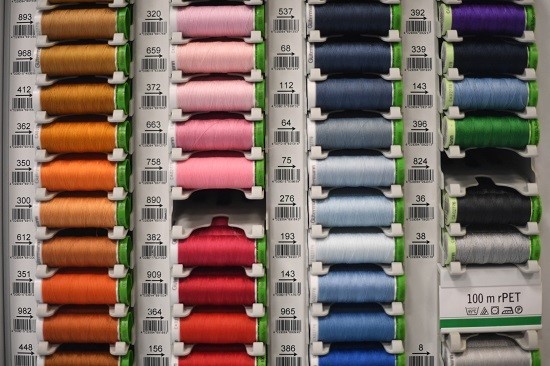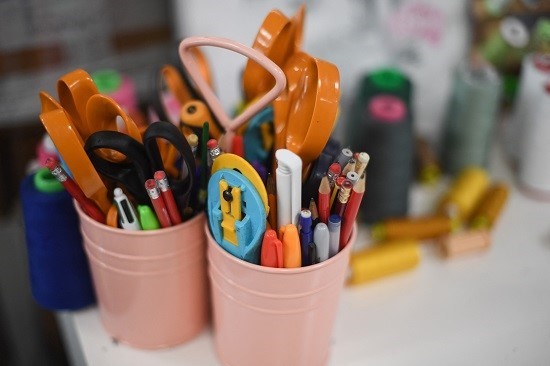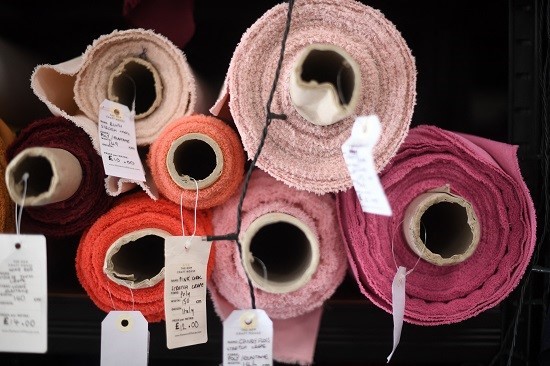LONDON — From jogging
outfits to summer
dresses, Lea Baecker has stitched together most of her wardrobe herself from
inside her London flat, part of a burgeoning number of young amateur
seamstresses.
اضافة اعلان
Like many others in the growing horde of
sew-it-yourself enthusiasts, she has grown increasingly disillusioned with the
retail clothing industry, viewing it as too destructive.
“My main motivation was not having to buy
ready-to-wear clothes anymore because I didn’t want to support fast fashion,”
Baecker, 29, told AFP, referring to clothes made and sold cheaply to be thrown
away after minimal use.
The doctoral student in
neuroscience only started
sewing in 2018, beginning with small bags before moving on to clothes.
Four years on, she estimates about 80 percent of
clothes in her wardrobe are homemade, from
pajamas to long fleece coats, as
well as jeans made with denim scraps scalped from relatives.
 (Photo: AFP)
(Photo: AFP)
Baecker now buys new clothes “very rarely”, she
added, wearing one of her self-made long, hand-sewn dresses.
‘Scale’
The fashion and textile
industry is the third most polluting sector globally after food and construction,
accounting for up to 5 percent of greenhouse gas emissions, according to a 2021
report by the
World Economic Forum.
Low-cost fashion retailers are regularly criticized
for their waste and pollution, as well as the pay conditions imposed on their
workers.
Tara Viggo knows fast
fashion only too well, having
worked in the industry for 15 years as a pattern maker.
“I realized the scale that the fashion industry was
working at and it was a bit terrifying,” she told AFP.
In 2017, Viggo decided to start creating her own
patterns — the blueprint drawings on paper before garments are made.
She started out small, selling only around one set
of patterns per year, a far cry from the four a day that she would sometimes
churn out in the ready-to-wear industry.
Viggo conceded independent operators like her were
only tiny competitors to the big
brands, but insisted they still could have a
meaningful impact.
“The more of us that do (it), the better,” she said.
 (Photo: AFP)
(Photo: AFP)
“It’s like a trigger... People start to look at
where their consumption” is, she added noting it also made you aware of the
true costs involved.
“Once you know
how to sew your own clothes, you can’t fathom that a shirt should be £3 ($4.10)
anymore.”
‘More young people’
Viggo’s “Zadie” jumpsuit is
now a top seller on “
The Fold Line”, an online platform selling independently
produced sewing patterns, according to its co-founder Rachel Walker.
Since its launch in 2015, the website has grown from
about 20 designers to more than 150 today.
Rosie Scott and Hannah Silvani, who run a
London workshop selling fabrics from fashion designers’ unsold stock, have also seen
the resurgence in sewing’s popularity, particularly among young people.
“The clients have changed,” said Scott.
“More young people have shown interest in sewing —
young people who are really interested in making their own clothes and making
them sustainably.”
Women make up more than 90 percent of the clientele,
she also noted.
 (Photo: AFP)
(Photo: AFP)
Customers can choose from some 700 designer fabrics,
sold from £8 a meter for cotton voile — a sheer, lightweight cotton fabric — to
£110 for the same length of lace.
Orders soared during the pandemic and are still
going strong despite the lifting of restrictions, Scott said.
Instagram key
The sector’s explosive growth would not have been possible without
Instagram, where the sewing community has made a pastime once seen as
unfashionable much more trendy.
The photo-sharing platform “is really important”,
Baecker said, allowing seamstress’ and artists to post images of their designs
and engage with each other.
This is what prompted her to join the social
network, where she now regularly shares her latest works.
“I found each pattern has a specific hashtag that
you can look up and then you can see a lot of different people wearing the same
pattern and you can imagine how it can look on yourself,” she explained.
For example, Viggo’s
#Zadiejumpsuit — which comes in
velvet or cotton, with or without sleeves — has been tagged in almost 11,000
posts.
Meanwhile, the hashtag
#handmadewardrobe features in
more than 900,000 posts.
With Baecker sharing so many of her creations, she
has also inspired friends to join the growing sewing revolution.
“That is my proudest achievement... getting my
friends into sewing as well,” she said.
Read more Fashion



